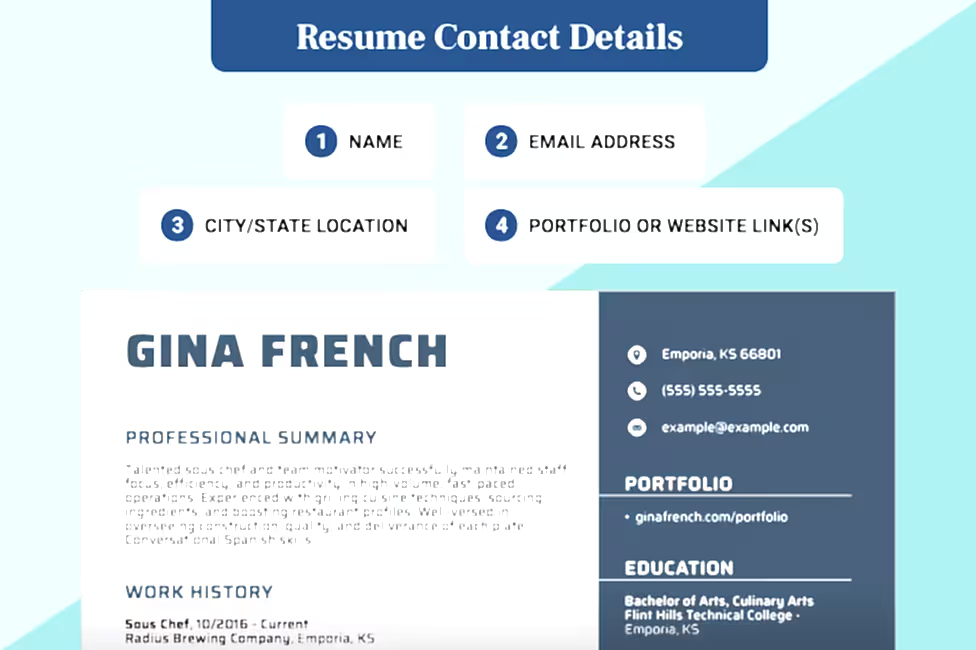What to include in your contact information for resume
Your contact information, also called a resume header, belongs at the top of your resume and should contain the basic details about how to reach you.
Here are the contact information must-haves to write your resume:
Here are optional contact information elements:
If you want to skip the reading and create a resume in under 15 minutes, use our best tool for the job, our Resume Builder.
It’s fully automated and guides you through each bit of information you must include in your resume, so you don’t have to worry about missing anything important!
Best of all, it comes loaded with 25+ resume design options, so you can skip the formatting and focus on winning the job
How to include contact info for resume + examples
Let’s start with the resume contact information essentials:
1
Your name
To make your name stand out, choose a big and bold font so recruiters can spot your resume quickly.

PRO TIP
Your name can be a font size between 20 and 24, the largest text on your resume. By contrast, section headings use a maximum font size of 18, and the main text should be kept at 12.
Your name should also match what’s listed on your LinkedIn profile or other social media to avoid confusion. If you have a preferred nickname you prefer, you could include it like this: e.g., Karen Taylor, Karen “Kiki” Taylor.
If you are going to include a professional title, like “CPA” or “Technical project manager,” ensure it gets listed right below your name in slightly smaller text, like this:
Example of how to include your professional title in your contact info:
2
Your phone number
Make sure it’s correct and include any international prefixes if you apply from a different country!
You could choose a phone format that fits your resume’s style, whether simple or modern.
Here are examples of how you can format a phone number in your contact information:
- (312) 555-5555 (simple)
- 312-555-555 (simple)
- 312.555.5555 (modern)
- +13125555555 (for international)
3
Your professional email address
By “professional,” this means the address you use is a reflection of your name or career, e.g., “Maria.Cruz114@———-.com” or “CruzTennisPro@———-.com”
Avoid the following when including email in your contact information:
- An email address from your current employer. This may suggest you’re using your time at work to look for other jobs, which is not flattering.
- Addresses that aren’t work appropriate, like: “Pizzalover43” or “Surferdude1111”
- Any email address with your birth year, like: “MariaCruz1987” could lead to age hiring bias issues.
- Any email account you don’t check regularly!
4
Your city/state location
Even if you’re applying for a remote job, it’s good practice to include your city/state location so employers can know where you are and your time zone.
If you’re applying abroad, you can also include the country.
Here are examples of all you need for your location:
- Monterey, CA
- Minneapolis, MN
- Birmingham, AL, USA (for international role)
It used to be standard to include your street address, but this practice is outdated in our digital age, as employers will reach out via telephone or email!
Next, we’ll cover the optional resume contact information. Only include this information if it seems fitting for the job.
To see what professionals in your industry do as standard practice, check out our vast library of resume examples. It’s got hundreds of job titles, so you can see what your job competition includes!
5
Your professional title
Adding a professional title to your contact information shows you identify with your work.
Including a professional title or heading in your resume contact info has these benefits:
- Shows your work is part of who you are.
- Confirms your desired position, especially if there is no job post or ad for your desired role.
- Helps managers keep resumes organized if they’re hiring for multiple positions.
However, including a title does eat up space on your resume, and you could make it clear what position you’re applying for in other ways, too, like in your email subject or your cover letter introduction paragraph.
6
Work-related social media
If you work in social media or keep an online presence showcasing your craft, it’s helpful to show employers what you do best.
LinkedIn is the most common social media platform where people share contact information in their resume because it can fit additional skills and work details.
That said, ensure your LinkedIn and resume are up-to-date and matching.
It may also be acceptable to share your Instagram, TikTok or YouTube if it’s related to the work you’d be doing or demonstrates your volume of followers and influence.
However, skip including any social media that’s personal or not work-appropriate.
Here’s an example of work-related social media in your contact information:
When including a hyperlink, click it to ensure it goes to your correct account address! Sending an employer a broken or incorrect link could cost you the job.
7
Personal website link
If you maintain a website for professional purposes, such as a writer or physical therapist, to advertise for freelance work or showcase your offerings or testimonials, share it with employers!
A personal website shows your commitment, enthusiasm and professionalism.
Examples of including your website in resume contact info:
8
Online portfolio link
Careers in creative industries like art, design, writing, video, marketing or UX, employers want to see examples of your work to assess your fit. If you work in an industry where portfolios are necessary, include a link to your online portfolio in your contact information!
Examples of including a portfolio in resume contact info:
If a portfolio is required, it usually says so in the job post or ad!
You could also research to see if portfolios are common in your industry.
Also, remember that you can also choose to attach the link to your portfolio when writing your cover letter.
Here are resume examples for industries that may want a portfolio link:
Key takeaways
To recap the main points about contact information on resumes:
- List the following essential information: first name, last name, phone number, email address and city/state location.
- Optional sections include: Your professional title, LinkedIn URL, social media profile(s) or portfolio link. Only add what seems necessary to the role!
- This section is straightforward, but you must get the details exactly right. So proofread all the information you include, mainly that your name, phone number and email address are correct.
- Including a LinkedIn profile may help you. Make sure it’s up-to-date and matches with your resume.
- Remember there are things you should NOT include on your resume. Skip on your current job email address or phone number, date of birth, unprofessional email address, or home address.
If you’re ready to write your document, you can skip the formatting steps using a resume template. A resume template is a preformatted design that takes care of your document’s headings, fonts and margins.
Professional designers created templates to save time and ensure you’ll like how your resume looks.
You can find 25+ resume templates in our Resume Builder. Since it’s automated, it will walk you step-by-step through each part of your contact information and other resume sections.
That way, your resume will have all the vital bits, and you won’t miss out on your dream job cause you forgot something!
Contact information on resume FAQ
Where should I put my contact info for my resume?
Your contact information is at the very top of your resume. It should be the first thing the employer reads!
It lives at the top of your resume before your professional summary, skills, work experience or education sections.
That way, tracking resumes is easier because they can spot your name immediately.
Is it important to include resume contact information?
Yes, 100%. Every resume needs to have your contact information.
Otherwise, an employer may not know how to reach you if they want to hire you!
For that reason, it’s also very important your contact information is correct. So, double- or even triple-check your contact info before sending your resume.
Should I put contact info on a resume for employment history?
When listing previous employers you’ve had in your work history section, there are a few essential details you need:
- Your position at the company
- The dates you worked there
- The company’s name
- The company’s city/state location
To list the contact information of a previous employer in your resume, provide their city/state location.
The city/state location is essential because employers need it to verify they’re contacting the right business if they want to inquire about you.
Another option, If you’re sending a digital resume, is to include a hyperlink to their company website on their name. It might look like this:
Server
May 2022-current
Fast Fields Restaurant
Tacoma, WA
That way, the employer can click it to get more information if they’re unfamiliar with the business. Adding it as a hyperlink also looks cleaner than listing a web address.
To create a hyperlink, type the name of the restaurant. Then, highlight the text and go to “insert link” (on Mac, ⌘K; on PC, “ctrl + K”). There, you can enter the company’s URL.
You may list the business phone number for easier reference. However, this is optional and may make your resume look cluttered!
Refrain from including their street address. It eats up too much space. And, most likely, they’re not going to send mailed questions.
Do I need to put contact info for volunteer work on my resume?
You only need to include the name of the organization you volunteered for and their city/state location. It works the same way as listing a paid job.
A phone number is optional. However, it may be helpful if a hiring manager wants to call anyone to verify your experience.
Related content
As seen in*
*The names and logos of the companies referred to in this page are all trademarks of their respective holders. Unless specifically stated otherwise, such references are not intended to imply any affiliation or association with LiveCareer.











